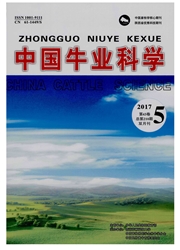

 中文摘要:
中文摘要:
[目的]对云南黄牛及其改良杂交牛西本杂和安本杂的牛肉氨基酸含量进行分析比较,旨在为云南肉牛生产及牛肉产品的深加工提供科学的依据.[方法]选择经育肥,年龄2~3岁的云南黄牛、西本杂、安本杂公牛各10头进行屠宰,选取胴体第6~7肋间的上脑部位进行粗蛋白和氨基酸含量的测定.[结果]表明,①云南黄牛的粗蛋白含量为21.32%,分别高出西本杂和安本杂2.19%、1.54%,且差异显著(P<0.05);氨基酸总量排序为云南黄牛22.61%>安本杂21.59%>西本杂20.70%,且云南黄牛与西本杂差异显著(P<0.05);必需氨基酸含量的排序为云南黄牛(9.47%)>安本杂(9.14%)>西本杂(8.82%),三组间无显著差异(P>0.05).②鲜味氨基酸的含量和占总氨基酸的比例都以云南黄牛最高,分别为6.62%和29.31%,但三组间无显著差异(P>0.05);甜鲜味氨基酸的含量以云南黄牛最高(4.33%),与最低的西本杂(3.92%)间的差异显著(P<0.05),甜鲜味氨基酸占总氨基酸比例以安本杂最高,为19.58%,但三组间无显著差异(P>0.05);苦味氨基酸含量云南黄牛最高为11.51%,但与西本杂10.62%和安本杂11.06%无显著差异(P>0.05),苦味氨基酸占总氨基酸比例以云南黄牛最低为50.88%,但三组间均无显著差异(P>0.05).③必需氨基酸评分(AAS)除安本杂的蛋氨酸+胱氨酸为96.72%,略低于标准模式外,其余所有评分均超过理想蛋白质模式,其中西本杂的蛋氨酸+胱氨酸在蛋白质中的含量及评分高于安本杂,差异显著(P<0.05);安本杂的苯丙氨酸+酪氨酸在蛋白质中的含量及评分高于云南黄牛,差异显著(P<0.05);其它氨基酸蛋白质中的含量及评分在三个组间差异不显著.[结论]综合分析,三品种牛肉均属优质蛋白质食物,云南黄牛无论是粗蛋白含量,还是氨基酸总量、必需氨基酸含量?
 英文摘要:
英文摘要:
[Objective] The purpose of this study was to compare the amino acid contents of Yunnan Yellow cattle (YY), hybrids of SimmentalX Yunnan Yellow (SY) and Angus ×Yunnan Yellow (AY) to promote the beef production and the beef processing in Yunnan province, . [Method] 2-3-years old bulls of Yunnan Yellow cattle, hybrids of Simmental × Yunnan Yellow and Angus×Yunnan Yellow were divid ed into 3 groups according to the breed or crossbreeds after fattening, respectively, then the 6-7th high ribs from carcass were cut and selected to evaluate the contents of crude protein and amino acid. [Result] The results showed: (1) The crude protein of YY (21.32%) was significantly 2.19% and 1.54% higher than those of SY and AY (P〈0.05), respectively. The total amino acid contents ranked as YY (22.61%) AY (21.59%) - SY (20.70%), and there was significant difference between YY and SY (P〈0.05). The essential amino acid contents was YY (9.47%) - AY (9.14%) - SY (8.82%), and there was no difference among the three groups (P〈0.05). (2) The contents of fresh flavor amino acid and its ratio in the total amino acids were the highest, 6.62 and 29.31% in YY, respectively, but no differences among the groups (P〈0.05). The contents of sweat flavor amino acids were the highest (4.33%) in YY, and lowest (3.92%) in SY, showing a significant difference between YY and SY (P〈0.05). The ratio of sweat amino acids in the total amino acids was the highest (19.58) in SY, and there was no difference a mong them. The contents of bitter flavor amino acids were the highest (11.51%) in YY, and 10.62% in SY and 11. 06% in AY, there was no significant difference among the three groups (P〈0.05). The ratio of bitter amino acids in the total amino acids was the lowest (50.88) in YY, and there was no difference a mong the three groups (P〈0.05). (3) Except for the contents of Met+Cys (96.72%) in AY slightly low- er than that of the standard pat
 同期刊论文项目
同期刊论文项目
 同项目期刊论文
同项目期刊论文
 期刊信息
期刊信息
